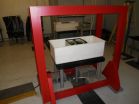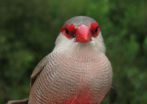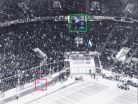(Press-News.org) A protein linked to Parkinson's disease may cause neurodegeneration by inhibiting autophagy—the process in which cells digest some of their contents—according to a study in the September 20 issue of the Journal of Cell Biology (www.jcb.org).
Autophagy serves to clear a variety of toxic waste from cells, including misfolded proteins and defective mitochondria. These two types of cellular trash accumulate in neurons from Parkinson's patients, suggesting that autophagy could be impaired in these cells. A commonly amassed protein in Parkinson's disease is alpha-synuclein, whose gene is often mutated or overexpressed in familial forms of the illness. David Rubinsztein and researchers from the University of Cambridge in England found that excess alpha-synuclein inhibits autophagy by blocking formation of the autophagosome—the double-membraned vesicle that engulfs cytoplasmic garbage and delivers it to lysosomes for destruction.
Previous research revealed that alpha-synuclein inhibits Rab1a, a small GTPase that controls secretory transport from the Endoplasmic Reticulum to the Golgi. Rubinsztein and colleagues now provide new insight into the role Rab1a plays in autophagy, and why blocking it has such dire consequences. The team found that lack of Rab1a impaired autophagosome formation, whereas an abundance of the GTPase reversed the inhibitory effects of alpha-synuclein on autophagy. Rab1a and alpha-synuclein act specifically at an early stage of autophagosome formation: an abundance of alpha-synuclein or lack of Rab1a disrupted an early acting part of the autophagy machinery called Atg9 and blocked the formation of autophagosome precursors known as omegasomes.
Alpha-synuclein's blockade of autophagy could enhance the gradual accumulation of toxic proteins and dysfunctional mitochondria, sensitizing neurons to cell death.
INFORMATION:
About The Journal of Cell Biology
Founded in 1955, The Journal of Cell Biology (JCB) is published by The Rockefeller University Press. All editorial decisions on manuscripts submitted are made by active scientists in conjunction with our in-house scientific editors. JCB content is posted to PubMed Central, where it is available to the public for free six months after publication. Authors retain copyright of their published works and third parties may reuse the content for non-commercial purposes under a creative commons license. For more information, please visit www.jcb.org.
Winslow, A.R., et al. 2010. J. Cell Biol. doi:10.1083/jcb.201003122.
Protein may advance Parkinson's by preventing neurons from clearing debris
2010-09-20
ELSE PRESS RELEASES FROM THIS DATE:
Magnetic attraction for fish, crabs?
2010-09-20
SEATTLE – Super-sized electromagnetic coils are helping explain how aquatic life might be affected by renewable energy devices being considered for placement along America's coastal waters and in the nation's rivers.
Scientists with the Department of Energy's Pacific Northwest National Laboratory are examining whether a variety of fish and invertebrates change their behavior during and after exposure to an electromagnetic field similar to those produced by marine and hydrokinetic power devices that capture energy from ocean waves, tides, currents and rivers. Research began ...
Female fish abandoned by males to raise offspring on their own
2010-09-20
Caring for children can be a tough job, particularly if you are a female cichlid fish.
Native to the crater lakes of Nicaragua, cichlid fish look after their young by defending them against would-be predators. While male and female cichlid fish generally share parental responsibilities, research shows that this is not always the case.
Conducted by an international team of researchers that included two biologists from Monash University, and published in the journal Behavioral Ecology and Sociobiology, new research has shown that male cichlid fish have a propensity ...
Secrets of birds' sexual signals revealed
2010-09-20
Patterned feathers, previously thought to be used only for camouflage in birds, can play an important role in attracting a mate and fending off rivals, a University of Melbourne study reveals.
Ms Thanh-Lan Gluckman, co-author of the paper and Masters of Philosophy student from the Department of Zoology at the University of Melbourne, Australia, said this finding brought a new perspective to research in animal communication and evolution.
"The implication of this study is that feathers don't need to be bright and showy to be used in sexual signalling and hence this changes ...
Protein behind development of immune system sentinels identified
2010-09-20
A protein called PU.1 is essential for the development of dendritic cells, the sentinels of the immune system, Walter and Eliza Hall Institute researchers in Melbourne, Australia, have shown.
Dendritic cells (DC) are immune cells that present proteins from foreign invaders, such as viruses, to the killer T cells of the immune system, allowing a full immune response to be mounted against the invaders.
Researchers from the Immunology division have been studying dendritic cells and how different molecules regulate their development.
Dr Li Wu said one of the molecules ...
Citizen scientist
2010-09-20
We are all scientists now, thanks to SETI@home, Galaxy Zoo, The Great Sunflower Project, Folding@home and counltess other projects that allow individuals to take part in scientific research directly or indirectly. In the case of SETI@home and Folding@home one shares one's computer CPU with the researchers, whereas Galaxy Zoo is more about active involvement with the classification of stellar objects in images of the night sky, for instance.
Now, writing in the International Journal of Organisational Design and Engineering, US researchers have mapped out an approach to ...
Marine scientists unveil the mystery of life on undersea mountains
2010-09-20
They challenge the mountain ranges of the Alps, the Andes and the Himalayas in size yet surprisingly little is known about seamounts, the vast mountains hidden under the world's oceans. Now in a special issue of Marine Ecology scientists uncover the mystery of life on these submerged mountain ranges and reveal why these under studied ecosystems are under threat.
The bathymetry of our oceans is now resolved at a scale and detail unimaginable by early pioneers and recent estimates suggest that, globally, there may be up to 100,000 seamounts, yet despite best efforts less ...
Study gets measure of how best to prevent blood clots
2010-09-20
Treating hospital patients with thigh-length surgical stockings, rather than knee-high socks, can reduce life threatening blood clots, a new study suggests.
Researchers found that knee-high stockings, which are similar to flight socks, do little in stroke patients to prevent deep vein thrombosis (DVT), a life threatening form of blood clot that can travel up into the heart and lungs, .
The CLOTS (Clots in Legs Or sTockings after Stroke) study from the University of Edinburgh highlights that the clot rate in stroke patients was higher among those fitted with the shorter ...
The Amazon rainforest -- a cloud factory
2010-09-20
The forest in the Amazon Basin produces its own rain. During the wet season, aerosol particles, which serve to condensate clouds and precipitation here, mainly consist of organic material. These aerosols are released by the rainforest itself. This has been demonstrated by scientists from the Max Planck Institute for Chemistry in Mainz, who are now able to draw conclusions about the mechanisms of this ecosystem: the high content of organic material indicates that the Amazon Basin acts as a largely self-contained biogeochemical reactor during the rainy season. The results ...
Vigilant camera eye
2010-09-20
»Goal, goal, goal!« fans in the stadium are absolutely ecstatic, the uproar is enormous. So it's hardly surprising that the security personnel fail to spot a brawl going on between a few spectators. Separating jubilant fans from scuffling hooligans is virtually impossible in such a situation. Special surveillance cameras that immediately spot anything untoward and identify anything out of the ordinary could provide a solution. Researchers from the Fraunhofer Institute for Applied Information Technology FIT in Sankt Augustin have now developed such a device as part of the ...
Image sensors for extreme temperatures
2010-09-20
More and more car manufacturers are equipping their vehicles with image sensors – e.g. to register the presence of pedestrians or vehicles in the blind spot or to detect obstacles when parking. The sensors must be able to function in extremely high temperatures and in blazing sunlight. If they are installed behind the rear view mirror or on the instrument panel, for example, they can get very hot. The Fraunhofer Institute for Microelectronic Circuits and Systems IMS in Duisburg has developed a CMOS (complementary metal oxide semiconductor) image sensor for an industrial ...







